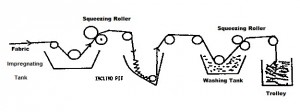Enzyme Desizing
Enzymatic desizing is a traditional desizing procedure of degrading starch size on cotton fabrics using enzymes. Enzymes are multipart organic, soluble bio-catalysts, created by living organisms that catalyze chemical effect in a biological process. Enzymes are quite specific in their act on a particular material. A small amount of enzyme is able to decompose a large quantity of the material.
Why Enzyme Desizing is Popular?
- No hydro-cellulose is formed, fabric strength remain changed.
- The process is continuous and speedy.
- The desizing capacity is more.
- Less floor space is required.
- Weight loss of fabric is less.
Continuous Enzyme Desizing Process
Normally when malt extract is used as the designing agent it takes about 3-4 hours for complete desizing to occur, but when stronger solutions of the extract are used to reduce the time within 5 minutes.

In this case, the impregnated fabric has to put in the required pit the length of the floor of the pit should be equal to delivered impregnated cloth in 5 minutes, so enzyme impregnated cloth, pit and washing machine should be synchronized with each other.
Written by
Engineer Sheikh Nurja
B.Sc engineer of textile
If you like this article please do not forget to share on facebook and put your valuable comments.


You are writing very good articles. I visit this site regularly. This site will help the students very much. Thanks for this informative post.